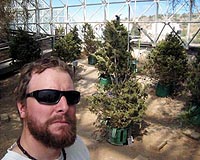| . |  |
. |
Portland OR (SPX) May 12, 2009 Creating diverse forests for multiple uses is important to natural resource managers and landowners. A study conducted in southwestern Oregon provides forest managers with information that offers choices when managing land for a variety objectives that may include a high level of wood production, a moderate level of wood production with some wildlife habitat features, or low wood production that provides cover and forage for a wider variety of wildlife species. "Land managers need effective approaches for creating and modifying forest stand structures to satisfy a broad range of objectives," explains Tim Harrington, a research forester at the Forest Service's Pacific Northwest Research Station. "Silvicultural treatments can be used to shift competitive interactions between conifers and hardwoods to create the desired balance between wood production and wildlife habitat." Harrington and John Tappeiner, an emeritus Oregon State University forestry professor, initiated a study in 1983 in southwestern Oregon on Douglas-fir plantations near Cave Junction and Glendale, Oregon. During the first phase of the study, when the plantations were 1 or 2 years old, a single herbicide treatment was used to reduce hardwood density to several levels. The Douglas-fir were thinned at age 15 to leave densities of 120 to 220 dominant trees per acre. About 8 years later (ages 23 to 25), the scientists found that three very different stand structures emerged. Highly productive, pure stands of Douglas-fir, 39 to 52 feet tall, occurred where hardwoods were completely removed at age 2 years. Where 25 percent of the original hardwood density was retained, moderately productive stands developed with two distinct canopy layers: Douglas-fir (39 feet tall) growing above hardwoods (23 feet tall). Where the original hardwood density was retained, Douglas-fir and hardwoods occupy the same canopy layer, 26 to 30 feet tall, in mixed stands that are low in productivity but may have the potential to provide cover and forage for a range of wildlife species. Each of the stand structures had different potentials for habitat and for wood production. Douglas-fir stand volume where all hardwoods were removed was about three times that where hardwoods were not removed, and these stands may provide wildlife cover for shade in summer and warmth in the winter. The stands with hardwoods will provide hardwood seeds for wildlife food, and birds can use hardwood layers in the understory for nesting and foraging. Douglas-fir mortality from black stain root disease was greater where all hardwoods were removed than where some hardwoods were retained. The disease is known to be spread during precommercial thinning operations because the fresh slash from thinning is colonized by insects, which carry the disease. It is unknown how long these stand structures will persist given future competitive interactions; however, differences in Douglas-fir yield among the three stand structures are likely to remain stable or even increase as the taller-growing species continues to exert its dominance. "Managing stands with moderate hardwood densities enables a stratified structure to develop with conifers and hardwoods occupying dominant and intermediate canopy layers, respectively," explains Harrington. "Combining high hardwood densities with precommercial thinning of Douglas-fir creates a codominant stand structure with conifers and hardwoods occupying the same canopy layer. Managers may also want to retain some hardwoods in areas prone to black stain root disease, since the hardwoods may reduce mortality of planted Douglas-fir following thinning." Share This Article With Planet Earth
Related Links USDA Forest Service, Pacific Northwest Research Station Forestry News - Global and Local News, Science and Application
 Biosphere 2 Experiment Shows How Fast Heat Could Kill Drought-Stressed Trees
Biosphere 2 Experiment Shows How Fast Heat Could Kill Drought-Stressed TreesTucson AZ (SPX) Apr 22, 2009 Widespread die-off of pinon pine across the southwestern United States during future droughts will occur at least five times faster if climate warms by 4 degrees Celsius, even if future droughts are no worse than droughts of the past century, scientists have discovered in experiments conducted at the University of Arizona's Biosphere 2. Their study is the first to isolate the impact of jus ... read more |
|
| The content herein, unless otherwise known to be public domain, are Copyright 1995-2009 - SpaceDaily. AFP and UPI Wire Stories are copyright Agence France-Presse and United Press International. ESA Portal Reports are copyright European Space Agency. All NASA sourced material is public domain. Additional copyrights may apply in whole or part to other bona fide parties. Advertising does not imply endorsement,agreement or approval of any opinions, statements or information provided by SpaceDaily on any Web page published or hosted by SpaceDaily. Privacy Statement |